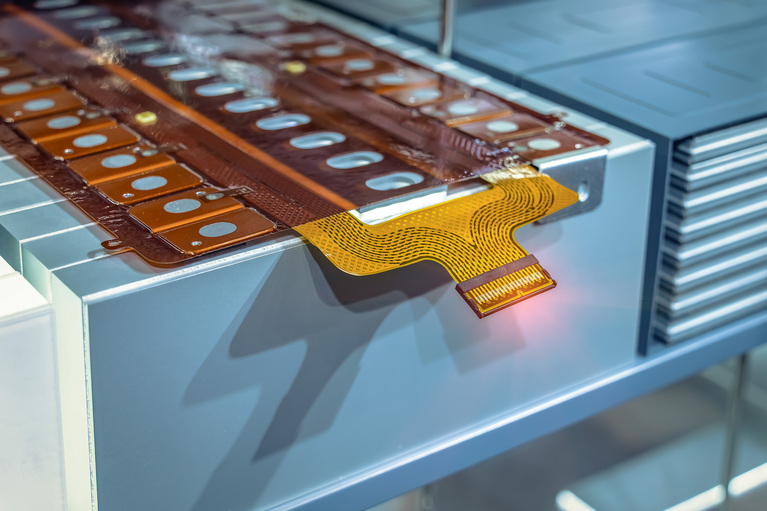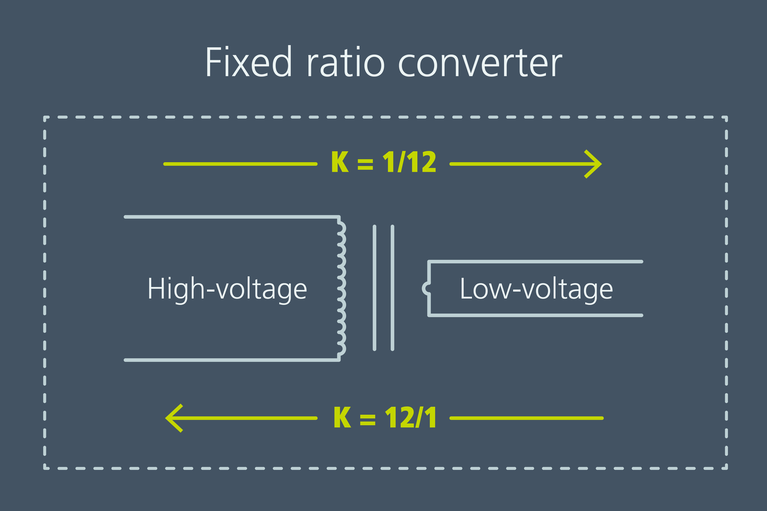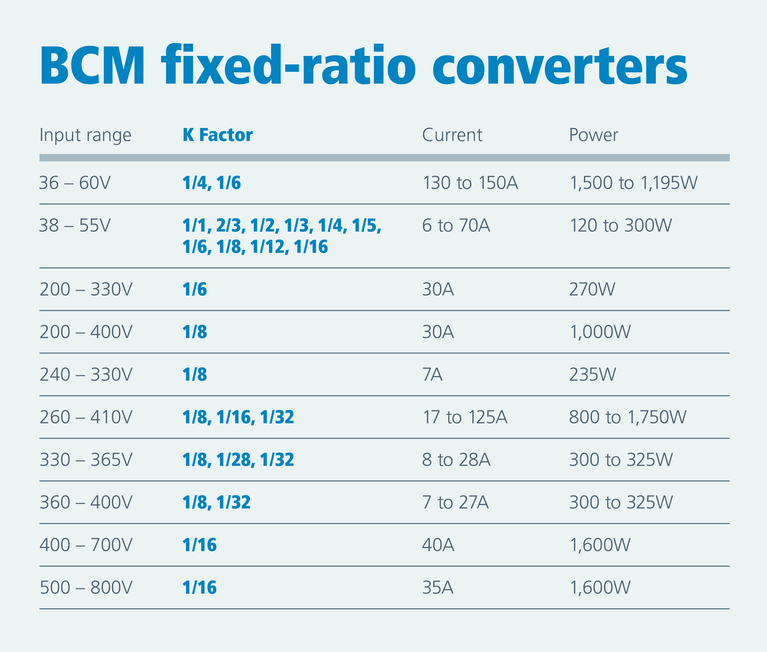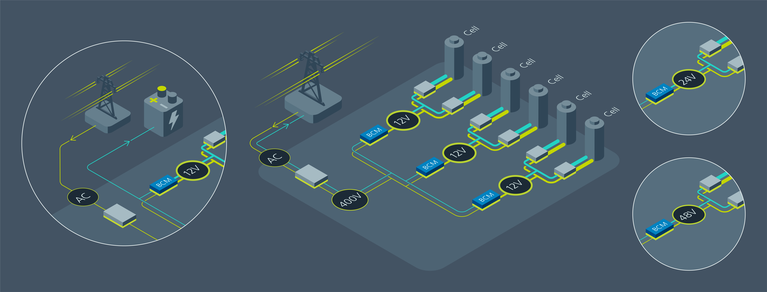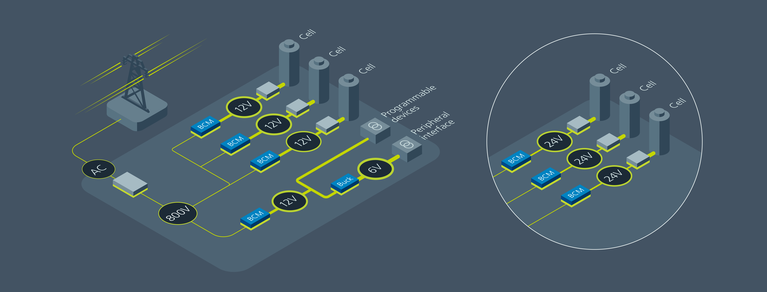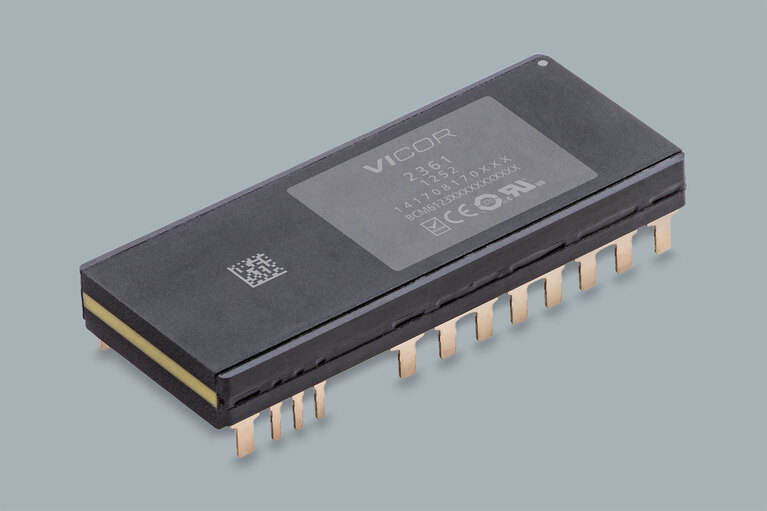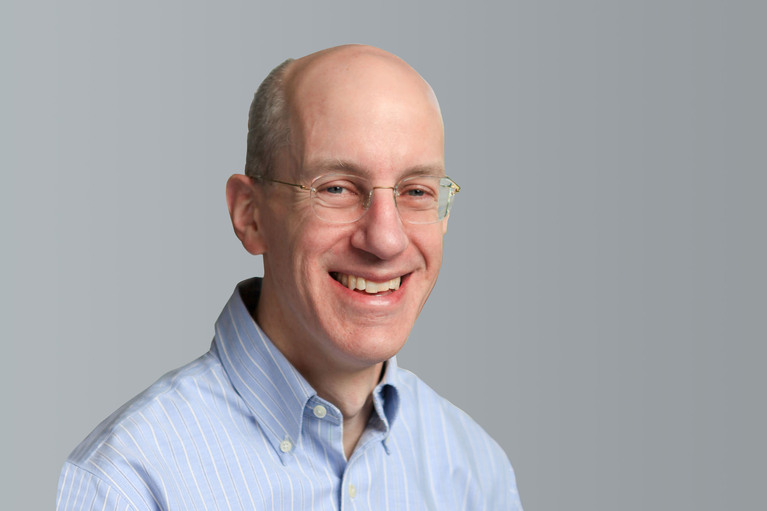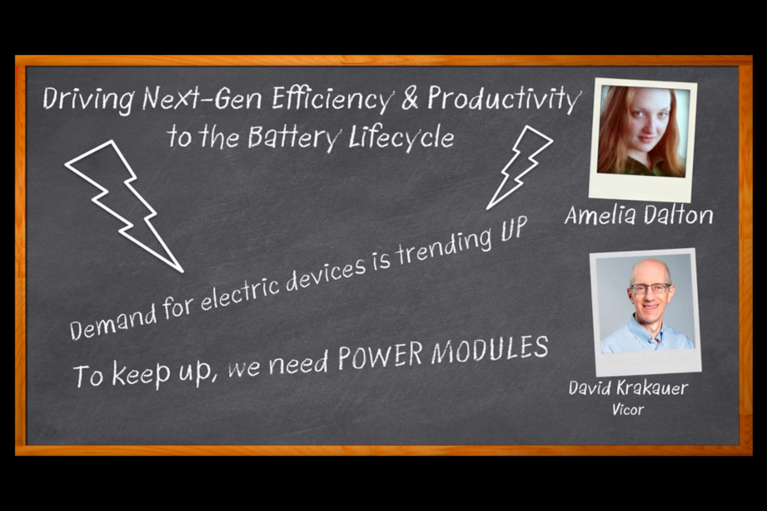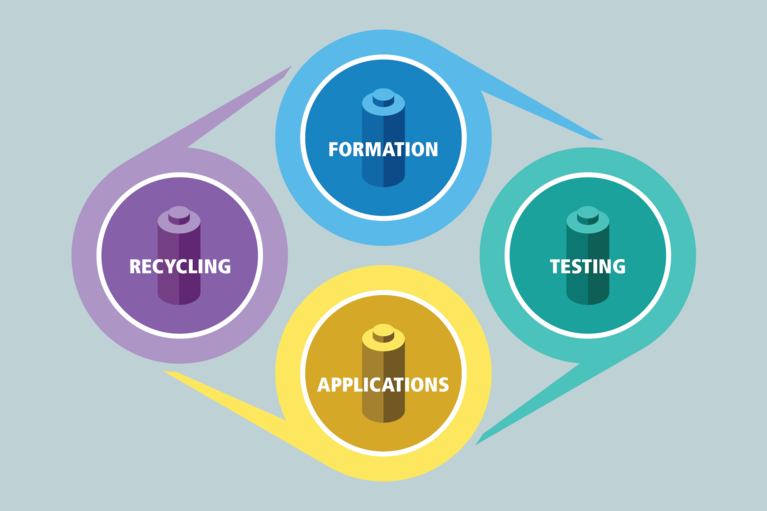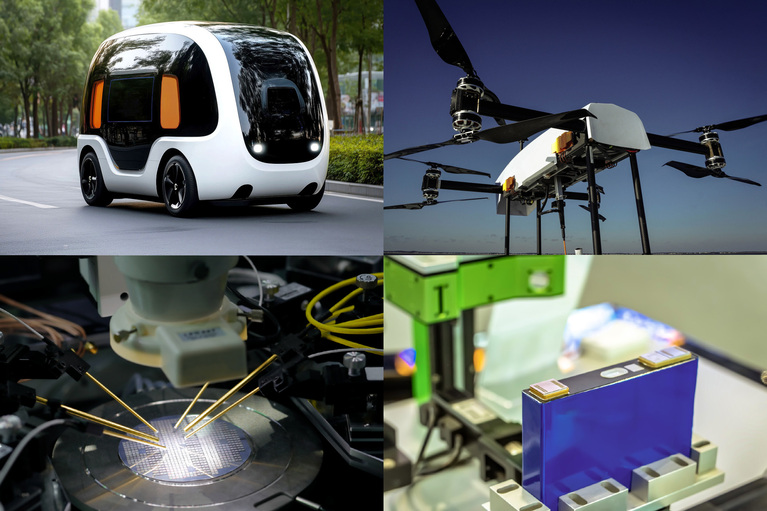
Accelerate your move to a high performance 48V power delivery network
This eBook provides guidance on designing 48V power delivery networks to enhance the performance, efficiency, and reliability of industrial products
To keep up with today’s surging demand for battery power, manufacturers and developers of battery cells and test equipment are exploring innovative ways to increase productivity without adding new costs. There are many hidden costs of battery cell formation and testing tools. To improve productivity fixed ratio converters can increase throughput, shorten cycle times, and conserve energy and time with bidirectional power converters.
By David Krakauer, VP of Global Marketing
The ongoing adoption of electrification across many industries has been a boon for productivity and the environment. Battery production has been a core technological enabler for this trend. Driven in part by electric vehicles (EVs) and energy storage systems for renewable energy, the battery industry is among the fastest growing in the world.
According to the International Energy Agency (IEA), global battery demand has increased tenfold from 43.8GWh/year in 2016 to 550.5GWh/year in 2022. Given the still-accelerating demand, every stage of the battery lifecycle merits examination. The battery lifecycle consists of four major stages: cell formation, battery testing, application use, and battery recycling. A shortcoming in any of these phases undermines the battery industry and the growth in electrification. Today, the battery lifecycle is constrained by limitations of existing power conversion technologies that threaten this growth. Vicor power-dense fixed-ratio converter technology brings a novel approach to achieving greater sustainability and cost-efficiency across all stages of the battery lifecycle.
In high-voltage battery systems, DC-DC power conversion is fundamental to the power delivery architecture.
DC-DC conversion is commonly achieved with switched-mode power converters like a buck or boost topology or low drop-out regulators (LDOs). While these power converters can be effective, they limit the flexibility and performance of the power delivery network (PDN) with the rigidity of their outputs and subpar conversion efficiencies. This is particularly true when working with high voltages associated with today’s battery systems.
To overcome these shortcomings, Vicor has developed fixed-ratio converters that provide highly efficient, isolated conversion in a small package for high-voltage to low-voltage loads, commonly called safety extra-low voltage. Analogous to a transformer in an AC-AC solution, a fixed-ratio converter performs DC-DC conversion with the output voltage being a fixed fraction of the DC input voltage (Figure 1).
Figure 1: A bidirectional fixed-ratio converter operating as a stepdown converter with K = 1/12 can also serve as a boost converter with a K of 12/1. This bi-directionality in a single module unlocks several unprecedented use cases for the battery industry.
Similar to a transformer’s step-down or step-up capabilities defined by the coil’s turns ratio, a fixed-ratio converter’s capabilities are defined by its K factor, which is expressed as a fraction relative to its voltage step-down capability (Figure 2).
Unlike traditional DC-DC converters that regulate the output voltage, a fixed-ratio converter provides no output regulation. These devices are also autonomous, requiring no feedback loop or external control mechanism.
Fixed-ratio converters offer several notable benefits over traditional converters.
Figure 2: With support for a large range of different K-factor and output-power configurations, Vicor BCM fixed-ratio converters can meet the needs of most applications.
These devices are inherently bidirectional since fixed-ratio converters operate independently of an external host or controller. This means that, depending on the direction of the current flow, the same fixed ratio converter module will step the voltage up or down. By achieving voltage boosting and bucking with one module, fixed-ratio converters unlock unprecedented flexibility and simplicity for PDNs that rely on the bidirectional current flow.
Fixed-ratio converters are exceptionally easy to parallel for higher power demands. Designers can easily add multiple fixed-ratio converter modules in parallel to scale a system to whatever output power demands are required. Similarly, designers can place multiple fixed-ratio converters in series to achieve unique voltage ratios based on their cascading K factors. In these cases, the converters must be power-matched to ensure safe and reliable operation.
Finally, fixed-ratio converters are unmatched in power efficiency from a small footprint. Whereas a conventional buck or boost converter achieves maximum power efficiencies in the low 90% range, fixed-ratio converters demonstrate conversion efficiencies up to nearly 98%, leading to more sustainable applications with decreased demand for thermal management overhead.
The first phase in the battery lifecycle is the cell formation stage.
In this phase, newly manufactured batteries must undergo the formation cycling process, which consists of charging and discharging a cell for the first time. During this process, a cell is cycled repeatedly to gradually build up the cell’s solid-electrolyte interphase (SEI) layer. The speed of this process is determined by cell chemistry, so cell formation latency is mostly a fixed-rate process.
Formation cycling in the battery requires an underlying power delivery network (PDN) that can support the repetitive charge and discharge cycles.
The standard PDN for such a system takes a three-phase AC input from the grid, rectifies it to high-voltage DC, and then uses multiple phases of DC-DC conversion to reach the nominal voltage required to charge a battery cell (e.g., 4.2V) (Figure 3). This final voltage required for battery charging will vary from plant to plant depending on the specific cell chemistry, but the several intermediary voltage drops from AC to a lower DC bus voltage, such as 12V, are standard across the industry.
Discrete component solutions are extremely difficult to design, require significant in-house power expertise, have a large BOM that presents cost and supply chain challenges, and increase time to market. Discrete solutions limit flexibility as they offer pre-defined output voltages. Where different cell chemistries require different voltages, it is more cost-effective for designers to create a flexible solution that they can modify based on cell chemistry. Discrete solutions don’t allow for flexible cell formation systems that can be dynamically modified for compatibility with multiple cell types.
Two major challenges exist with PDNs in battery formation: throughput and efficiency.
From a throughput perspective, cell chemistry inherently limits the speed at which manufacturers can form a battery’s SEI layer. Hence, improving the cost-efficiency of the cell-formation process necessitates scalable systems that can form many batteries in parallel. However, with existing PDNs, the lack of a modular intermediary DC-DC phase limits the ability to scale a system easily without major design overhauls.
The constant charge and discharge of cells is costly from an efficiency perspective. To optimize efficiency, battery manufacturers reuse the energy spent during cell charging cycles by either storing it locally or sending it back to the grid on discharge cycles. This requires a PDN that supports the bidirectional flow of current and performs high-efficiency power conversion.
In both instances, fixed-ratio converters are ideal solutions. By integrating a fixed-ratio converter into the PDN, designers can redefine the architecture into three distinct phases: AC rectification, transformation to low voltage, and constant-current conversion (bus converter).
In the constant-current conversion stage, designers can implement fixed-ratio converters to easily step down the higher DC level to a safer, lower level without needing discrete or single-module solutions. By simply integrating one or multiple fixed-ratio converters in parallel, designers can create a power delivery network that is modular and easily scales.
This way, designers can make systems that cycle many batteries concurrently, enabling higher throughput, greater power density, and improved efficiency. Additionally, this architecture allows designers to easily change the PDN to accommodate the required DC-DC conversion for a cell’s unique nominal voltage. With a more flexible solution that requires no discrete components, designs reach the market faster and are less susceptible to failure.
The inherently bidirectional nature of a fixed-ratio converter is ideal in the cell-formation process for power conservation. With fixed-ratio converters, cell manufacturers can easily switch between charge and discharge cycles, knowing that the fixed-ratio converter will automatically step up to a pre-defined higher voltage on discharge and similarly step it down on charging cycles. This unique feature improves process energy efficiency, enabling energy reuse during formation cycling.
Additionally, with a fixed-ratio converter efficiency of 97.9%, the conversion cycle has minimal power loss in either direction. Without fixed-ratio converters, such bidirectionality would necessitate multiple components (one for buck and one for boost). This would consume more power due to lower efficiencies and increased component count.
Figure 3: Battery manufacturers can use fixed-ratio converters to integrate bidirectionality and efficiency into cell formation power delivery networks.
The next stage in the battery lifecycle is battery testing, where manufacturers combine battery cells into larger battery packs. Battery pack production is not constrained by the same chemistry-dependent time requirements related to the charging and discharging of cells, but it still faces similar throughput challenges.
For example, each cell must be properly tested and accurately measured to combine multiple cells to form a larger battery pack. Then, the larger battery pack also needs to be rigorously tested. This is not a value-add step, so the faster manufacturers complete this process, the lower the overall cost of the battery pack.
Flexibility and scalability in a PDN are needed to accommodate the wide variety of battery voltages and power levels, and high throughput is needed to test more batteries in the same physical space and in less time. Battery pack testers, therefore, need power delivery networks that are modular and scalable to the specific needs of their testing requirements and volumes. Like in the cell formation phase, the standard PDN of a battery testing facility entails converting power from AC three-phase down to the cell’s nominal voltage (Figure 4).
With fixed-ratio converters in the constant-current conversion stage of the PDN, battery test designers can avoid arduously designing the intermediary conversion stages. Instead, they can trust that their constant-current conversion is managed by the fixed-ratio converter. Designers can now focus on the final stage of the conversion process, where voltages need to match the cell’s nominal voltage for testing. This simplified architecture creates modular and flexible systems that designers can readily modify for varied testing requirements.
Another important benefit of fixed-ratio converters is power density. With extremely high power efficiencies and small form factors, fixed-ratio converters can support kilowatts of power and hundreds of volts in industry-leading form factors. This helps support greater throughput testers by allowing more testing equipment to fit within the same area constraints, hence creating the opportunity to test more battery cells concurrently.
Figure 4: Fixed-ratio converters unlock high levels of power density for battery-testing power delivery networks, enabling greater tester throughput by fitting more testing equipment into the same area.
When the battery finally makes it out of the factory floor and into a real-world application, the challenges with PDN do not end.
There is a growing demand for extremely high-voltage power delivery in many emerging battery-powered applications, such as tethered robotics or ROVs, energy storage systems for renewables like solar and wind power, and electric vehicles (Figure 5). For example, electric vehicles are seeing a shift in architecture from 400V to 800V power delivery for greater power and efficiency.
Higher voltage levels allow for power delivery at lower currents for the same power. Therefore, one benefit of high-voltage power delivery is greater efficiency, as lower currents incur fewer I2R losses. This enables more efficient applications that also require less overhead for thermal management.
Additionally, high-voltage power delivery decreases the wire gauge in vehicle wire harnesses. With lower current delivery requirements, designers can use smaller-diameter cables, resulting in decreased system weight, material requirement, and cost.
Naturally, the successful operation of such high-voltage systems relies on the ability to convert these high-voltages used in delivery to the lower voltages used at the load. At this point in the battery’s lifecycle, fixed-ratio converters offer value by providing a simple and efficient means of DC power conversion.
Consider the example of a tethered robot. With a 1/16 K factor fixed-ratio converter, designers can use the 97.9% efficiency to step down voltages from the high voltage for power distribution (e.g., 800VDC) down to a lower voltage, like 48VDC. From the 48VDC, designers can use a conventional 90% efficient buck converter to reach the final 3.3V used for a microcontroller unit (MCU). Without a fixed-ratio converter, the entire conversion from 800V to 3.3V would occur at 90% efficiency, incurring significantly greater losses than the fixed-ratio converter architecture.

Figure 5: Applications like tethered robotics can use fixed-ratio converters to enable high-voltage power delivery without incurring significant power losses during conversion to lower voltages.
Once a battery has served its useful lifespan, the final stage in its lifecycle is recycling.
Battery recycling entails a high-power electrochemical process in which the raw materials and elements from the battery are chemically separated from the cell to be reclaimed and reused in the future. Like other industrial stages of the battery lifecycle, the PDN consists of converting three-phase AC input voltages to high-power DC and ultimately down to lower voltages to operate the recycling equipment (Figure 6).
One challenge from the PDN perspective is that the battery recycling process creates a significant amount of heat. Therefore, the components within the PDN must be able to operate reliably at elevated temperatures. Similarly, power density becomes increasingly important in the design of the PDN, necessitating small form factors and high-efficiency power conversion.
Fixed-ratio converters offer an extremely power-dense solution to DC-DC conversion, capable of supporting kilowatts of power at hundreds of volts in extremely small form factors.
Figure 6: BCM fixed-ratio bus converters allow for reliable high-power-voltage conversion within the elevated temperature constraints of a battery recycling plant.
For example, the Vicor BCM6123 fixed-ratio bus converter boasts a power density of 2352W/in3 (Figure 7). With this level of power density, designers can easily meet the temperature and performance requirements of battery recycling plants. As power requirements and demand continue to grow, the modular power architecture enabled through fixed-ratio converters allows the system to scale up accordingly with minimal overhead.
There is a growing need for high-voltage power delivery networks that are efficient, power-dense, and scalable at each stage of the battery's lifecycle. Success in the battery lifecycle necessitates success at each stage, whether battery cell formation, testing, in-application use, or recycling. Fixed-ratio converters benefit the entire battery lifecycle. Compared to traditional power conversion solutions, fixed-ratio voltage converters offer unprecedented levels of efficiency and small form factors while presenting unique features like bidirectional operation.
Figure 7: The Vicor BCM6123 fixed-ratio bus converter module offers a 24V output voltage and 62.5A output current while in a 61.0 x 25.14 x 7.26mm ChiP™ package.
Vicor BCM® products employ a Sine Amplitude Converter™ topology, allowing higher-frequency operation than PWM-based solutions. The BCM family of fixed-ratio converters comes in various form factors and power ratings to support the needs of various high-voltage and other applications.
The BCM fixed-ratio converter is poised to play a significant role in the growth of battery manufacturing, one of today’s fast-growing markets. They support greater throughput, enhance efficiency, and scale with any application. Regardless of the application or lifecycle phase, fixed-ratio power converters are an exceptional solution for the burgeoning modern battery industry, which traditional power-conversion approaches can limit.
This article was originally published by EE Power.
David manages all marketing activities including corporate branding, promotion, and communications, and is charge of driving revenue for Vicor’s Industrial business unit. Krakauer has a BSEE and MSEE from the Massachusetts Institute of Technology as well as an MBA from the MIT Sloan School of Management.
David Krakauer, VP of Global Marketing
Accelerate your move to a high performance 48V power delivery network
This eBook provides guidance on designing 48V power delivery networks to enhance the performance, efficiency, and reliability of industrial products
Driving next-gen efficiency and productivity to the battery lifecycle
With soaring demand for batteries today, how can production keep pace? Learn why Vicor power dense modules are perfectly designed to meet today’s demands
Fixed-ratio converters charge up efficiency across battery lifecycle
Power conversion technology limits battery lifecycle productivity. Vicor high-density fixed-ratio converters enable greater efficiency
Fixed-ratio converters unleash innovation across the battery lifecycle
Bidirectional DC-DC converter play a vital role in the evolving battery ecosystem. Learn how high-density power modules are driving new productivity
